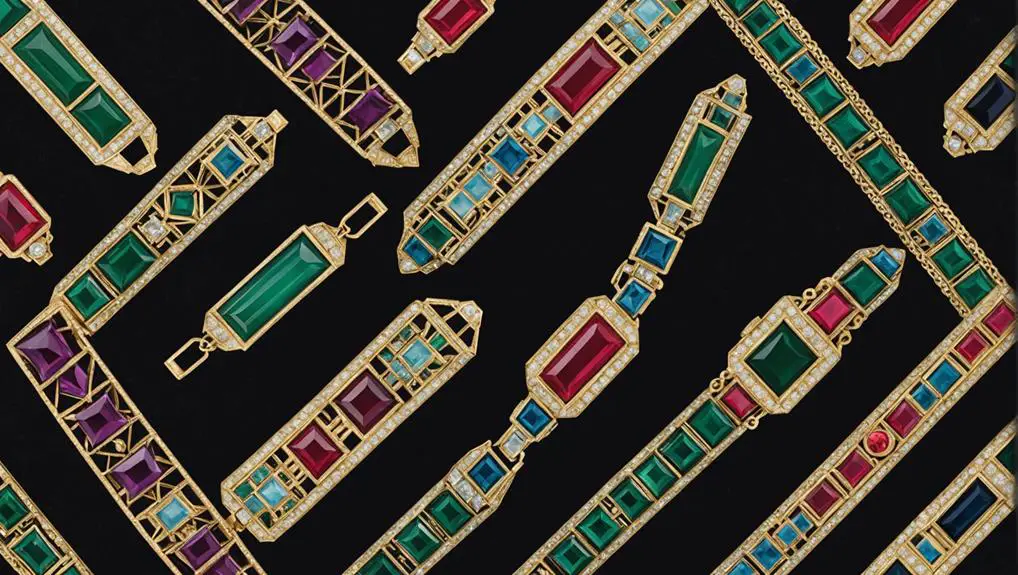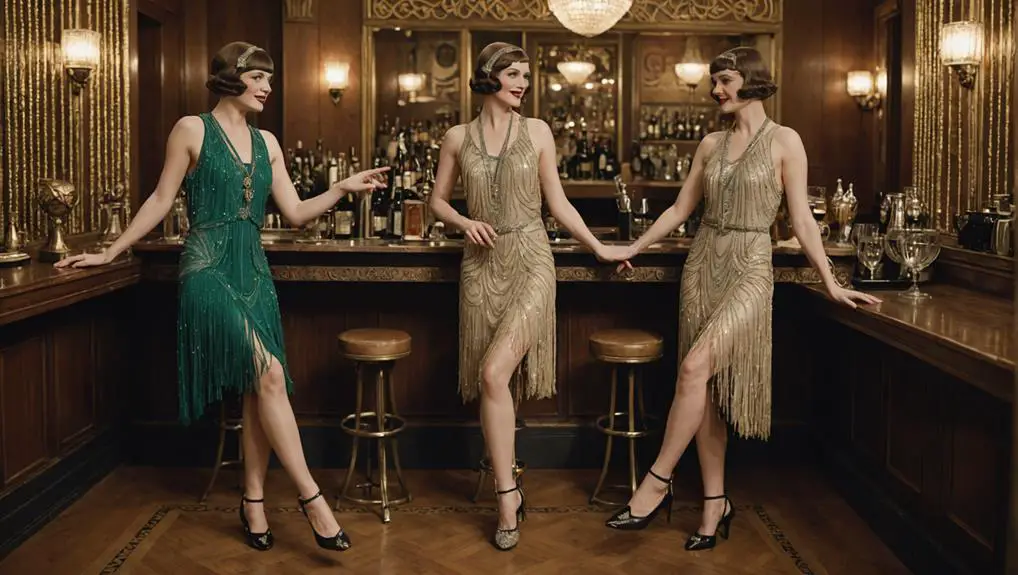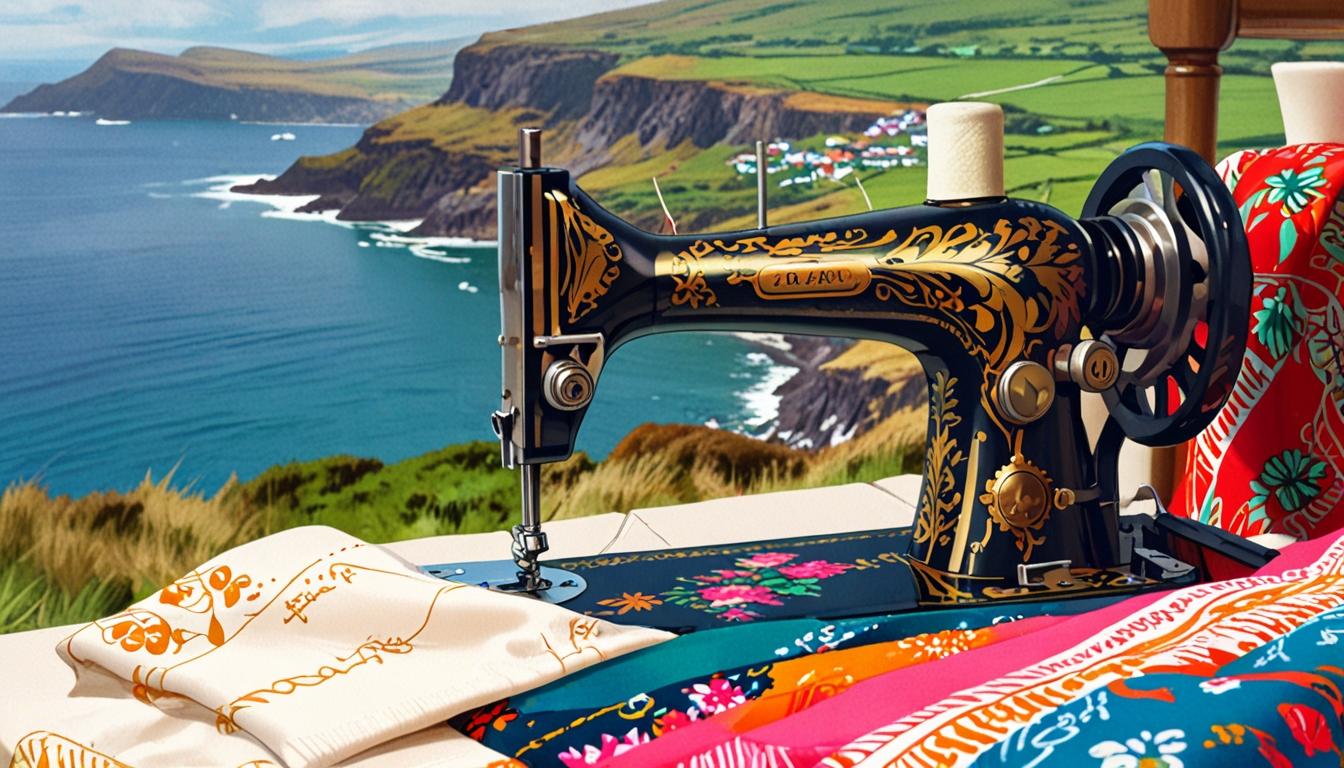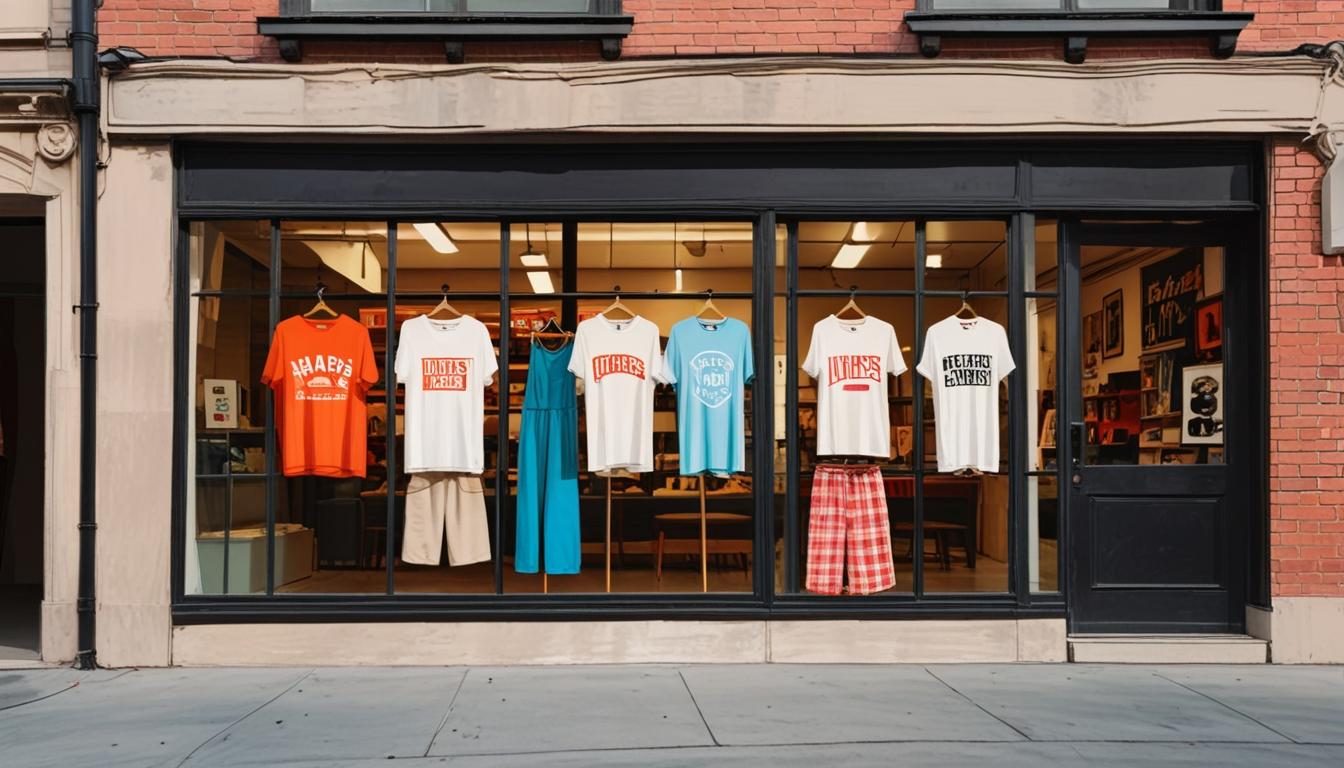In the 1920s, women's Art Deco bracelets became symbols of freedom and modernity, reflecting the cultural shift of the era. These pieces showcased bold geometric shapes and vibrant colored gemstones like rubies, sapphires, and emeralds. Crafted in luxurious materials such as platinum and gold, they were essential accessories for the flapper aesthetic. Designers like Cartier and Tiffany & Co. pushed boundaries, combining intricate patterns with exceptional craftsmanship. The unique styles ranged from flexible bangles to rigid cuffs, enchanting collectors and fashionistas alike. To appreciate fully the artistry and significance of these pieces, you might want to explore their fascinating history further.
Historical Significance of Art Deco Bracelets
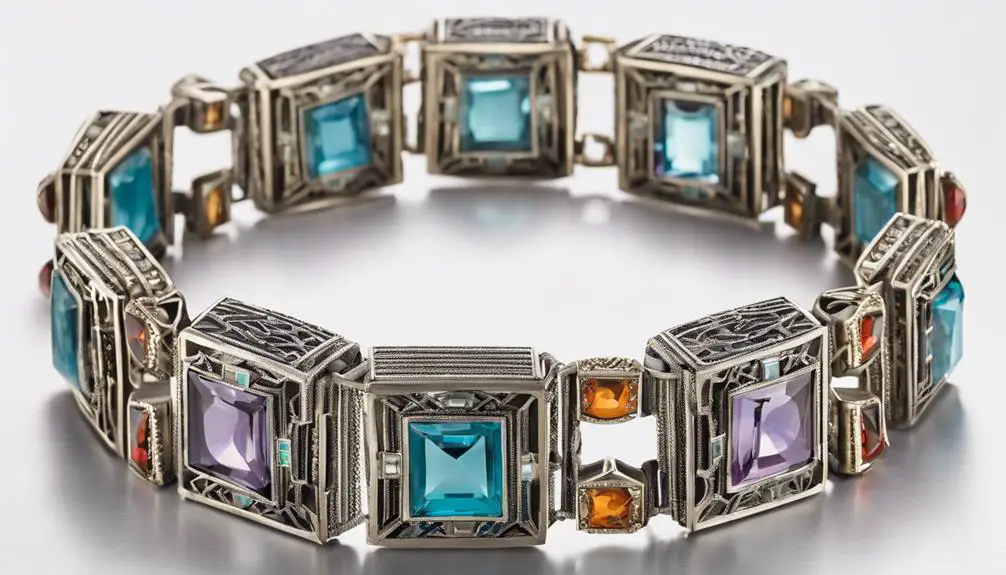
The allure of Art Deco bracelets from the 1920s lies in their historical significance, embodying the spirit of a transformative era. These striking pieces of Art Deco jewelry didn't just adorn wrists; they symbolized a cultural shift toward modernity and freedom in women's fashion. As you explore these bracelets, you'll notice their bold geometric forms, reflecting the influence of Cubism and Futurism, which marked a departure from traditional designs.
Crafted from platinum and vibrant gemstones, these bracelets showcased exceptional craftsmanship and inventive material use, highlighting the luxury of the Jazz Age. They served as essential accessories for the flapper fashion movement, a manifestation of women's newfound independence and expressive lifestyles during the Roaring Twenties. This historical significance extends beyond aesthetics; each bracelet encapsulates the post-World War I optimism, representing a break from the past and an embrace of a brighter future.
Today, Art Deco bracelets are not just jewelry; they are collectible artifacts that invite you to connect with an era defined by innovation, artistic exploration, and a celebration of life. By appreciating their historical context, you gain insight into the evolving role of women and the rich cultural tapestry of the 1920s.
Key Design Features
Art Deco bracelets from the 1920s are distinguished by their striking geometric shapes and intricate patterns that resonate with the modernist aesthetic of the time. These pieces often feature bold motifs, creating a visual rhythm that draws the eye. While Art Deco diamonds were occasionally used, the era favored vibrant colored gemstones like Deco rubies and emeralds, showcasing a preference for lively and expressive elements that reflected the culture of the Roaring Twenties.
The craftsmanship of these bracelets is equally remarkable; many incorporate delicate white gold filigree, characterized by lace-like designs that add an air of sophistication. This intricate work highlights the artisans' skill and dedication to quality. Additionally, decorative elements such as millegrain settings and detailed engravings enhance the overall visual appeal, making each bracelet unique.
The use of luxurious materials, including platinum and gold, further elevates these designs. The combination of geometric forms with exquisite craftsmanship results in pieces that are not only fashionable but also timeless. Each bracelet tells a story of innovation and artistry, embodying the spirit of a transformative era in jewelry design.
Popular Materials Used
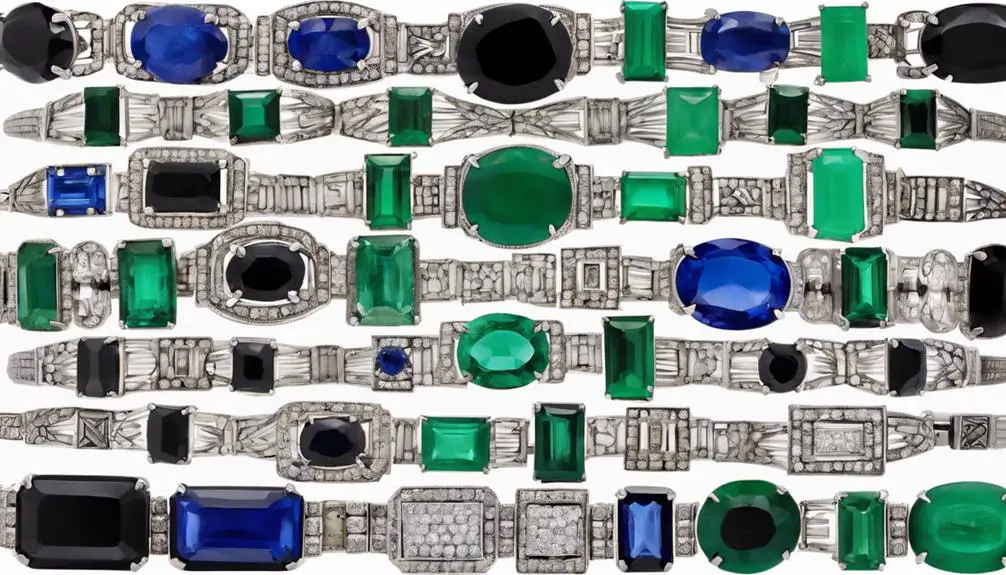
While exploring the materials used in women's Art Deco bracelets from the 1920s, you'll find that luxury and innovation played essential roles in their design. Platinum and gold dominated the landscape, with both metals prized for their durability and aesthetic allure. The exquisite sheen of platinum, in particular, allowed for intricate designs, while gold provided a warm contrast that appealed to the fashionable elite.
In addition to these precious metals, vibrant colored gemstones like sapphires, emeralds, and rubies became staples, enhancing the bold geometric forms typical of the Art Deco style. You'll notice that many bracelets incorporated synthetic stones alongside natural gems. This blend reflected not only the era's technological advancements but also a desire for affordability without sacrificing elegance.
Diamonds, too, were central to these creations, often showcased in changeover and European cuts. The interplay of light from these diamonds added to the luxurious aura of the bracelets. Moreover, intricate decorative elements like filigree and millegrain settings highlighted the exceptional craftsmanship that defined the period. Together, these materials created pieces that were not just jewelry, but statements of art and status.
Iconic Styles and Variations
Embracing the bold aesthetic of the 1920s, women's Art Deco bracelets showcased a stunning array of iconic styles and variations that defined the era. These pieces often featured bold geometric designs, reflecting the modern spirit of the time. You'd find flexible bangles that hugged the wrist, rigid cuff designs that made a statement, and multi-strand options ideal for layering. The craftsmanship was impeccable, with decorative elements like filigree and millegrain enhancing their charm.
Art Deco bracelets made extensive use of luxurious materials like platinum, reminiscent of the elegance found in a platinum wedding band or an art deco wedding band. These designs often incorporated vibrant gemstones, such as Deco Carved Jade, diamonds, sapphires, and emeralds, creating a mesmerizing visual contrast. The trend leaned toward an eclectic mix, as colorful stones complemented the classic brilliance of diamonds.
As you explore these bracelets, you'll appreciate how they embody a fusion of elegance and innovation, making them highly collectible today. Their iconic styles not only reflect the fashion of the 1920s but also continue to influence modern jewelry design, marking them as timeless treasures in the world of vintage fashion.
Famous Art Deco Bracelet Designers

Throughout the 1920s, several renowned designers greatly shaped the landscape of Art Deco bracelets, each bringing unique artistry and innovation to their creations. Cartier stood out for its groundbreaking use of gemstones, crafting intricate designs that embodied the era's luxurious spirit. Their bracelets often featured stunning diamond clusters, showcasing the brilliance of Art Deco platinum in a way that captivated jewelry enthusiasts.
René Lalique also made waves with his iconic bracelets that celebrated natural motifs through the use of enamel and glass. His work reflected the artistic trends of the time, merging nature with modernity. Similarly, Tiffany & Co. distinguished itself by incorporating geometric patterns into their exquisite Art Deco bracelets, using high-quality materials that further solidified their legacy.
Van Cleef & Arpels introduced the innovative "Mystery Set" technique, allowing for seamless gemstone settings that defined their unique style. Boucheron and Chaumet contributed to this decorative movement, creating pieces that combined luxurious materials with bold artistic expressions. Each designer played an essential role in shaping Art Deco's visual language, leaving an indelible mark on the world of women's bracelets in the 1920s.
Collecting and Valuing Art Deco Bracelets
Collecting Art Deco bracelets from the 1920s offers a fascinating glimpse into a vibrant era defined by bold design and luxurious craftsmanship. These pieces not only showcase unique aesthetics but also hold considerable value for collectors. When evaluating the worth of Art Deco bracelets, consider the following key factors:
- Craftsmanship: Intricate designs and high-quality materials, such as platinum and gold, enhance desirability.
- Condition: Well-preserved pieces command higher prices; any damage can greatly impact value.
- Rarity: Limited-edition or unique designs are more sought after, often fetching higher auction prices.
- Designer Signatures: Bracelets bearing notable designer marks can greatly increase their market value.
Market trends indicate a rising interest in Art Deco jewelry, particularly among vintage enthusiasts. This growing demand emphasizes the importance of both aesthetic appeal and historical significance. High-quality Art Deco bracelets can range from several hundred to tens of thousands of dollars, making them an attractive investment. As you explore collecting, keep these factors in mind to enhance your experience and investment potential in the enchanting world of Art Deco jewelry.
Care and Maintenance Tips
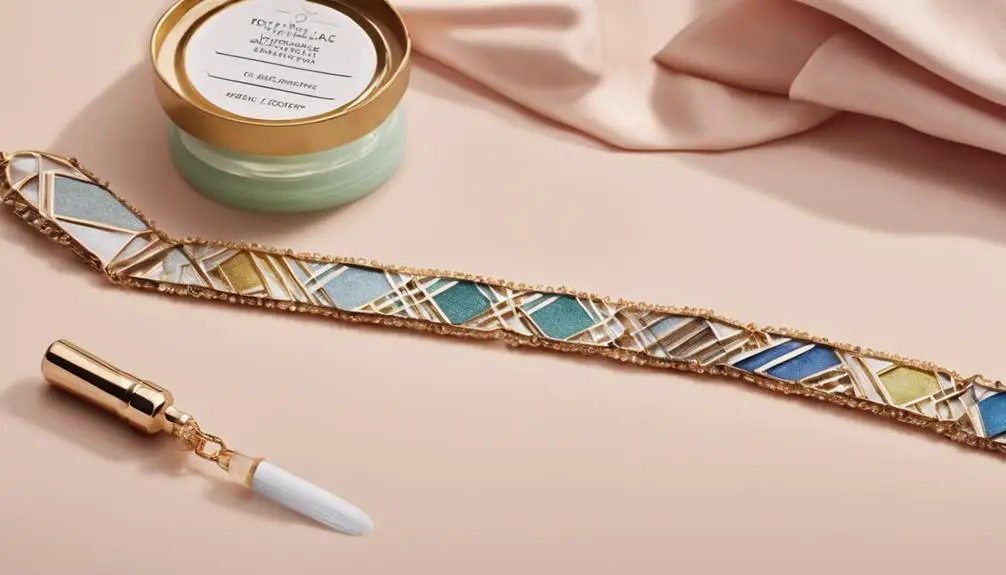
To keep your Art Deco bracelets looking their best, regular care and maintenance are essential. Start by cleaning them frequently with a soft, lint-free cloth. This simple action removes dirt and oils that can dull their shine, guaranteeing they remain radiant. Be careful to avoid exposing your jewelry to harsh chemicals found in household cleaners or perfumes, as these can damage the delicate materials and stones.
When it comes to storage, always keep your bracelets in a separate, soft-lined jewelry box or pouch. This prevents scratches and tangling with other pieces, which could compromise their beauty. For those bracelets featuring intricate designs or gemstones, consider professional cleaning and maintenance every few years. This not only enhances their longevity but also preserves their brilliance.
Lastly, it's wise to be cautious when wearing your Art Deco bracelets during physical activities or swimming. Sudden impacts or exposure to water can lead to damage or loosening of stones, jeopardizing your cherished pieces. By following these care and maintenance tips, you'll guarantee your Art Deco bracelets remain stunning for years to come.
Modern Influences and Revivals
As you maintain and cherish your Art Deco bracelets, it's fascinating to observe how their influence continues to shape modern jewelry design. The resurgence in vintage jewelry interest has sparked a revival of these iconic pieces, known for their geometric designs and vibrant colored gemstones like Deco Aquamarine. Contemporary designers are embracing the intricate craftsmanship and bold aesthetics of the 1920s, integrating them into new collections that appeal to today's fashion sensibilities.
Here are four ways modern influences are keeping Art Deco relevant:
- Social Media Impact: Platforms and influencers showcase vintage-inspired looks, connecting with younger audiences who appreciate the style's unique charm.
- Auction Value: The rising prices of well-preserved Art Deco pieces highlight their enduring appeal and lasting value, making them coveted items for collectors.
- Blending Styles: Brands are producing modern adaptations that mix traditional Art Deco elements with contemporary materials, guaranteeing they fit seamlessly into modern wardrobes.
- Wedding Jewelry: Art Deco bracelets are increasingly popular in wedding attire, symbolizing elegance and timeless beauty in special moments.
These ongoing influences guarantee that the legacy of Art Deco continues to thrive.
Frequently Asked Questions
How Can You Tell if Jewelry Is Art Deco?
To tell if jewelry's Art Deco, check for bold geometric shapes, symmetrical designs, and intricate engravings. Look for vibrant colors and high-quality materials, like platinum and gemstones, showcasing skilled craftsmanship typical of the era.
What Kind of Jewelry Was Popular in the 1920s?
In the 1920s, you'd find bold geometric designs, vibrant colors, and intricate craftsmanship dominating jewelry. Popular pieces included multi-strand necklaces, elegant earrings, and statement bracelets, all reflecting the era's modernist aesthetics and flapper fashion influences.
What Is Art Deco Bracelet?
An Art Deco bracelet's characterized by bold geometric designs, vibrant colors, and intricate craftsmanship. It blends traditional elegance with modern flair, making it a fascinating statement piece that reflects the artistic movements of its time.
What Was the Art Deco Style in the 1920s?
The Art Deco style in the 1920s represents a fusion of modernity and luxury, characterized by bold geometric shapes, vibrant colors, and intricate craftsmanship that embraced new technologies and materials, transforming design aesthetics in various art forms.
